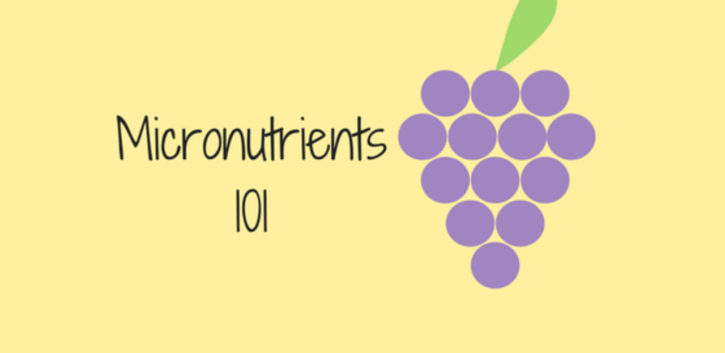 Micro is a shortened term for micronutrients, which are commonly referred to as “vitamins and minerals.” Unlike macronutrients (carbs, fat, and protein), which you can read about here, the body only requires a small amount of vitamins and minerals hence the term “micro.”
Micro is a shortened term for micronutrients, which are commonly referred to as “vitamins and minerals.” Unlike macronutrients (carbs, fat, and protein), which you can read about here, the body only requires a small amount of vitamins and minerals hence the term “micro.”
I could go on forever about micronutrients because there are so many of them with many different purposes and functions, but for the sake of time (and short blog posts) I’ll only touch on a few key micros that you may or may not be familiar with.
Vitamins:
Vitamin C aides in the absorption of iron, protects against free radicals, and helps with wound healing and building a strong immune system. One fun fact is that 1 cup of red bell peppers actually contain more Vitamin C than an orange! Sources: green pepper, red peppers, broccoli, oranges, strawberries, Brussel sprouts.
Vitamin A helps vital organs work properly and plays a role in healthy vision, reproduction, and the immune system. Sources: sweet potato, spinach, carrots, cantaloupe, peppers, mango, black eyed peas.
Vitamin D aids in immunity function and heart health. Vitamin D with the addition of calcium helps the body maintain strong bones. Sources: swordfish, salmon, tuna, milk, yogurt, eggs.
Vitamin K aids in blood clotting and supporting healthy bones. Sources: collards, turnips, spinach, kale, broccoli (i.e. dark leafy greens)
Minerals:
Calcium is needed for strong bones and teeth. It also helps release enzymes and hormones for important bodily functions. Sources: kale, broccoli, dairy products (milk, yogurt, cheese).
Iron is used to make hemoglobin which carries oxygen to all parts of your body. Sources: beans, peas, spinach, meat, seafood, nuts, and fortified cereals.
Zinc aids in wound healing and boosting immunity. Studies have shown that ingesting zinc at the onset of a cold could shorten the length of time you feel sick. Sources: oysters, lobster, beef, chicken, yogurt.
Selenium is important for reproduction and thyroid gland production. It protects the body from free radicals and infection. Sources: brazil nuts, shrimp, yellowfin tuna, eggs, spinach.
Magnesium has an important job of regulating blood pressure, blood sugar levels, and muscle and nerve function. Sources: legumes, nuts, seeds, green leafy vegetables.
The amount of each nutrient needed varies from person to person and depends upon age, current nutrient level, and current disease state to name a few. Micronutrients are a prime example of why health experts stress a diet that consists of a wide variety of whole foods. No one food contains everything we need. So, choose a wide variety of unprocessed whole foods that vary in flavor, shape, color, and nutritional content. Hence the phrase “eat the rainbow!”
If you take away only one thing from this post, make it this: Micronutrients are so very important and vital to our health and wellbeing. And eat the rainbow… oh, and if you hear people refer to Macros, or Micros, this is what they are talking about. Macros- carb, protein, fat. Micros- vitamins & minerals.
….okay that was three takeaways! 😉
https://www.nia.nih.gov/health/vitamins-and-minerals
